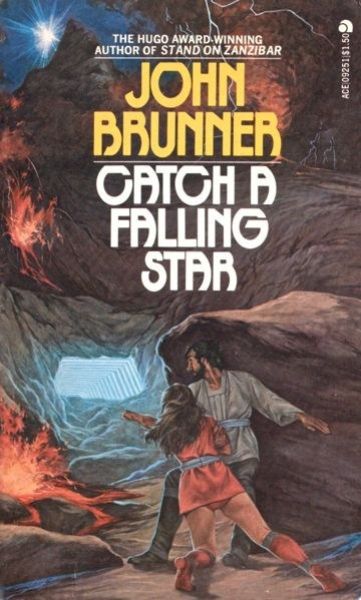How I Wonder What You Are
Catch a Falling Star
By John Brunner

27 Dec, 2022
John Brunner’s 1968 Catch a Falling Star is a substantial rewrite of his 1959 The 100th Millennium, which in turn is an expanded version of the 1958 novella Earth Is But a Star.
One hundred thousand years from now, a community of humans lives in what past eras would call utopia. Each person has their own living house that provides them with life’s necessities and each is free to pursue whatever pastime amuses them. Creohan, for example, is an astronomer, devoting his life to studying the stars.
As a consequence of a hundred thousand years of history, novelty is rare. Whatever a person might consider doing has been done a thousand times before. But … thanks to historical data provided to him by a Historicker friend, Creohan succeeds connecting dots no other person has connected:
A rogue star is headed directly for the Solar System. Earth and everything on it are doomed.
Creohan is determined to do something to save humanity and the Earth on which it dwells. What that something might be, he has no idea. As he tries to draw the attention of his fellow citizens to the danger, he discovers that those around him are happy to enjoy lives focused on nostalgia and their immediate pleasures. Saving the world (particularly from a doom centuries away) does not interest them.
Creohan finds only two similarly minded people in his community; the young woman Chalyth, an experienced wanderer, and Glyre, an even more experienced explorer who is, alas, so experienced he is now too old to accompany Creohan and Chalyth. Otherwise, Creohan’s immediate community is useless for his purposes. If salvation exists, it must be elsewhere. Creohan and Chalyth set out to find more open-minded people who might have the desire and skills to save the Earth.
This era in human history is one of small, closed communities, between which there are no long-range communication networks and few roads. Maps are likewise in short supply. The two travelers make their way from place to place without a grand plan; they usually find the ruins of dead cities. Those few people they find and recruit lack the skills needed to save Earth.
The scene changes when Creohan is captured by a would-be conqueror, Creohan convinces his captor to transport Creohan and his party across the great ocean to a vast continent. That continent has been home to most of Earth’s most notable civilizations. Perhaps there, salvation can be found.
The adventurers find a thriving, advanced, civilization. Unlike Creohan’s homeland, it is not lost in self-indulgence and dreams of yesterday. However, the scholarly community of that continent regards practical labor as beneath their dignity. Creohan will get no real help from them.
~oOo~
No doubt it wouldn’t be that hard to track down copies of the 1959 version, The 100th Millennium1, but I’ve opted to review the 1968 revised edition. First of all, this is no doubt the edition Brunner would have preferred people to read. And then … I am lazy. I’ve owned the 1977 Ace mass market paperback since it was published and I see little point in looking for the earlier, deprecated version.
Modern readers may be flabbergasted by Brunner’s suggestion that people, presented with an existential threat, would just shrug their shoulders and ignore it. It’s important to bear in mind the era when this was written, the age of “I’m all right, Jack” when many people preferred to focus entirely on their immediate concerns. Living as we do in a far more socially conscious age, no doubt the announcement of an threat to Earth’s environment would inspire an immediate, organized, global effort.
Catch a Falling Star appears to have had only a handful of editions, at least in English.
(covers featured immediately below)

This may be because while this novel is vastly superior to Galactic Storm in terms of prose and characterization, it has some serious issues, the most pressing of which is an enormous spoiler that I will rot13.
Abguvat gur punenpgref qb znggref, ng yrnfg nf sne nf gur fcrpvsvp vffhr bs gur ebthr fgne vf pbaprearq. Vaqrrq, gurer jnf arire na npghny pevfvf, nf Perbuna jnf vtabenag bs ivgny vasbezngvba nobhg gur ebthr fgne.
Otherwise, readers looking for a novel in which a small group of people wander the strange autumnal world2 of the distant future might like this book. A thousand centuries of human civilization has transformed the Earth in curious ways. Lacking a map as they do, the characters are forced to explore regions better informed people would have avoided. The novel is full of sensawunda, particularly where the rogue star is concerned. The setting is more memorable than the actual story.
Catch a Falling Star is available here (Amazon US), here (Amazon Canada), here (Amazon UK), and here (Chapters-Indigo). I didn’t find it at either Barnes & Noble or Book Depository. Available editions appear to be ebook only.
1: Tracking down Science Fantasy, v10 #29 to read the original form of Earth Is But a Star seems a task unlikely to succeed. That said, the novella is included in (and provides the title for) Damien Broderick’s 2001 theme anthology Earth Is But a Star: Excursions Through Science Fiction to the Far Future, which is still available for a hefty price, at least at Amazon.
2: The setting isn’t a dying Earth. Save for the possible interstellar interloper, this Earth is in pretty good shape, even if the human cultures on it are taking a breather. There is no reason civilizations could not rise and fall for thousands of millennia.
